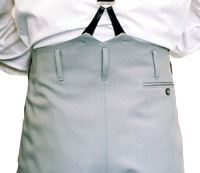Ok, so I've covered black tie and white tie, but what about something a bit more useful to the casual gent, how to choose and wear a suit. So here's a pretty comprehensive guide.
The Jacket
So, like the dinner jacket, you have two general options: single or double breasted. Let's start with the more attainable single breasted jacket. It should have either two or three button closure. I find a two-button looks better on shorter men, while three button is better on taller men. Men of average height, rejoice, both look fine on you. Also, you will have the choice of either single or double vented. A vent is the opening at the back of the jacket. I prefer single vents, but that's a matter of personal preference. Lapels should be either notch or peaked, but be careful with lapels, especially peaked. If they are too wide or too thin, they'll look ridiculous.
Now, for double breasted jackets, I recommend against the 2/6 button variety. This means that there are six buttons, but only the bottom row fasten. These don't flatter most men. I recommend a 4/6 jacket for most men, and possibly a 6/8 jacket for the EXTREMELY tall. You'll have a choice of double vented or no vents. Personally, I prefer no vent. Double breasted jackets should always have peaked lapels.
Both styles of jacket should be tightly tailored at the waist. They will vary in length as well but, obviously, a shorter jacket looks better on shorter men while a longer jacket looks better on taller men. Some fun additions are a ticket pocket (a smaller pocket above the right pocket) and working sleeve buttons or "surgeons cuffs." Pockets can be flap or patch, but patch pockets are far more casual. Most jacket pockets will be sewn shut, but I recommend cutting them open, especially the breast pocket for a pocket square. A working lapel hole is also recommended (or, for double breasted jackets, one on each lapel). There are also some cool back patterns not commonly seen anymore, such as belted and vented backs.
Pants/Trousers
You have several options here. First off, pleated, flat-front, or inverted pleats. Flat front is far more flattering for almost all body types, but good on ya if you can pull off pleats. Pants should sit at your natural waist with either a belt or button-on suspenders. Now, you have the option of cuffs. Cuffs will make a short man look shorter, so I recommend them for average height or tall men. There are many pocket types to try. There are several types of slanted top-pockets, forward set vertical pockets, and western pockets.
Those, as well as back pockets, are up to personal preference. Back pockets can be either no-button, button-through, button-loop, or button flap. I recommend having both belt loops and suspender buttons on pants. Other fun additions are a pocket-watch pocket (a small pocket above or inside the right trouser pocket. If above the pocket, may have button flap) or a fishtail back.
You can also go with a button fly if you want, but this is hardly necessary.
Vest/Waistcoat (optional)
Vests should have around 6 buttons (double or single breasted. Double may have 8) and extend above the gorge (neck opening) of the jacket UNLESS the jacket is double breasted, in which case the gorge should match EXACTLY to the jacket. It can have up to four pockets (5 if it has a ticket pocket) and can have besom, flaps, or welt. I recommend welt. The single breasted can have shawl or notch lapels, or no lapel. Double breasted should have shawl or peak lapels. Double breasted vests go with single breasted jackets. Single breasted vests go with both jackets. All vest should fit tightly and overlap the pants by about an inch. ALWAYS wear suspenders with a vest, no belts.
Fabric colors
For the most part, I'll leave this to your discretion, but you can't go wrong if you start with black, navy, or dark grey. Pinstripes are good for all body types, but tall men should have wider spaced stripes. Checked are good for all as well, but windowpane patterns are good for taller, thinner men. The higher the wool content, the better.
How to match Shoes to Suit
General rule, brown shoes go with white/off white, brown/tan, blue, and lighter grey suits. Black go with just about all suit colors.
That's about all for now. I'll expand again at some point for accessories, ties, and other bits and bobs. Goodnight for now.




No comments:
Post a Comment